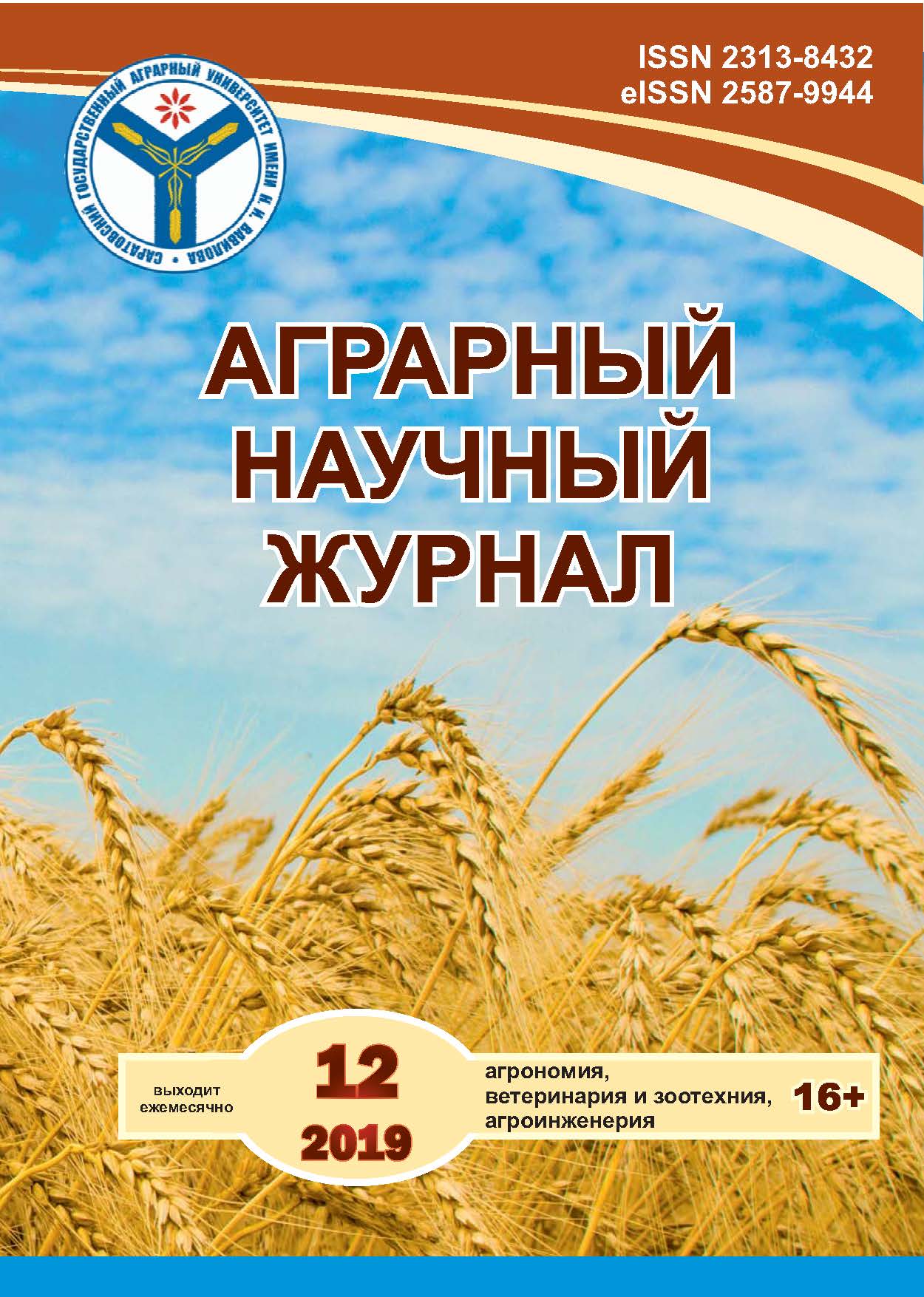Effect of insecticidal treatments on the effectiveness of protection of pea crops from bruchus (bruchus pisorum L.)
DOI:
https://doi.org/10.28983/asj.y2019i12pp4-8Keywords:
peas, pea seed, insecticides, application time, biological efficiency, yield, profitabilityAbstract
The article analyzes the effectiveness of protective measures of peas from pea beetles. Field experiments were conducted in 2010-2015 in LLC "Commodity economy" Engels district of Saratov region. It is established that the extended period of hatching of larvae and their short-term open stay on pea plants leads to low efficiency of processing at the larval stage and gives reason to consider as an option the use of insecticides against imago. The biological effectiveness of insecticides approved for use on peas was evaluated. The effectiveness of different terms and multiplicity of insecticidal treatments was studied. 5 insecticides from different chemical groups were used in the experiment: actara – neonicotinoid (250 g/kg thiamethoxam); synthetic pyrethroids Karate Zeon – (50 g/l lambda-cyhalotrin) and Fastak (100 g/l alpha-cypermethrin); combined drugs Borey – (150 g/l Imidacloprid+ 50 g/l lambda-cyhalotrin) and Eforia (141 g/l thiamethoxam+ 106 g/l lambda-Cyhalothrin). In the studies conducted to identify the optimal timing of insecticidal treatments, the highest biological effect was obtained on the variant with two treatments: the 1st treatment at the beginning of hatching of larvae + the 2nd treatment at the beginning of mass hatching of larvae. Comparing the percentage of damage to pea beans at different terms and multiplicity of treatments, as well as taking into account the yield obtained - the most optimal period of chemical treatments from bruchus-the beginning of hatching of larvae (10% of empty ovipositors). With a single treatment at the beginning of hatching larvae achieved the highest economic efficiency. Insecticidal treatments in this period, the highest yield of peas was obtained on the variant with the use of a two-component drug Borey-2.45 t / ha. On this variant, on average, for six years, the largest increase in yield to the control was obtained - 0.41 t / ha or 20%. The use of all studied insecticides is economically justified, but the highest indicators of net income and profitability were obtained when using the two-component drug Borey-the level of profitability of 86 %.
Downloads
References
2. Вахитова Р.К., Шарипов Х.Г. Влияние гороховой зерновки на посевные качества семян гороха // Фитосанитарное оздоровление экосистем: материалы Второго Всероссийского съезда по защите растений. Санкт-Петербург, 5–10 декабря, 2005 г. – Санкт-Петербург, 2005. – Т. 2. – С. 407–408.
3. Доспехов Б.А. Методика полевого опыта. – М. :Агропромиздат, 1985. – 351 с.
4. Еськов И.Д., Ботова Е.А. Совершенствование системы защиты посевов гороха в условиях степного Поволжья // Сб. тр. Межд. научно-практ. конф. «Вавиловские чтения 2016». – Саратов, 2016. – С. 204.
5. Илларионов А.И., Разумейко И.Н. Фитофаги гороха и приемы ограничения их вредоносности // Вестник Воронежского государственного аграрного университета. – 2018. – № 3 (58) – С. 20–31.
6. Методические указания по регистрационным испытаниям инсектицидов, акарицидов, молюскоцидов и родентицидов в сельском хозяйстве / под ред. В.И. Долженко [и др.]. – Санкт-Петербург, ВИЗР, 2004. – 363 с.
7. Мониторинг основных вредителей посевов гороха и технология защиты (Рекомендации) /А.В. Ермаков [и др.]. – М.: ФГНУ «Росинформагротех», 2002. – 32 с.
8. Нарушев В.Б., Юрченко Е.А. Адаптивные технологии возделывания полевых культур в Поволжье // Вестник Саратовского госагроуниверситета им. Н.И. Вавилова. –2004. – № 4. – С. 27–28.
9. Обзор фитосанитарного состояния посевов сельскохозяйственных культур в Российской Федерации в 2014 году и прогноз развития вредных объектов в 2015 году. /сост. Д.Н. Говоров. – М., 2015. – 717 с.
10. Обзор фитосанитарного состояния посевов сельскохозяйственных культур в Российской Федерации в 2011 году и прогноз развития вредных объектов в 2012 году. /сост. Д.Н. Говоров. – М., 2012. – 389 с.
11. Основа научных исследований в растениеводстве и селекции / А.Ф. Дружкин [и др.]. – Саратов, 2013 – 264 с.
12. Перспективная ресурсосберегающая технология производства гороха: метод. рекомендации. — М.: ФГНУ «Росинформагротех», 2009. – 60 с.
13. Радевич Е.В. Инсектициды для защиты гороха от основных вредителей // Известия Оренбургского государственного аграрного университета – 2015. –№ 2 (52). – С. 65–68.
14. Рекомендации по интенсивной технологии возделывания гороха на зерно / сост. Д.М. Бояр. – Гродно, 2010. – 16 с.
15. Сорта растений, включенные в Государственный реестр селекционных достижений, допущенных к использованию (А) /ФГБУ «Государственная комиссия Российской Федерации по иcпытанию и охране селекционных достижений». – Режим доступа: https://reestr.gossort.com/reestr.








